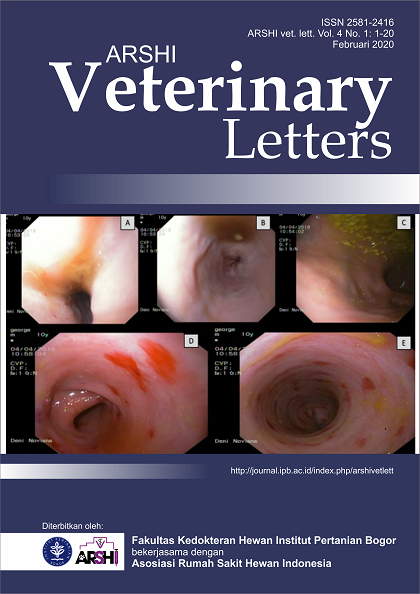Blood AST and ALT profile of Sumba Ongole cattle
Abstract
A study was carried out in one of Indonesia native cattle, Sumba Ongole (SO) Cattle for determination of statuses of various biochemical parameters, aspartate aminotransferase (AST or SGOT) and alanine aminotransferase (ALT or SGPT). Apparently blood from randomly selected cattle (n= 36) were collected aseptically. Biochemical analysis of AST and ALT was performed on UPT. Laboratorium Kesehatan, Kupang, NTT. The results showed that the variations of parameters were not significant (p>0.05) between male and female SO cattle. The AST/SGOT (142.56±20.55 U/l) was slightly higher in female compared with the male (137.00±16.24 U/l), while level of ALT/SGPT were 46.44±10.99 U/l in male and 46.41 ± 10.23 U/l in female. Although, the result was not significant (p>0.05), level of AST and ALT in SO cattle was higher compared to standard which is 60-125 U/l for AST and 6.9-35 U/l for ALT. Results showed possibility of seasonal effect on AST/ SGOT and ALT/SGPT level in male and female SO cattle.
Downloads
References
Alameen AO, Abdelatif AM. 2012. Metabolic and endocrine responses of crossbred dairy cows in relation to pregnancy and season under tropical conditions. American-Eurasian Journal of Agricultural & Environmental Science. 12(8):1065-1074.
Bedenicki M, Potocnjak D, Harapin I, Radisic B, Samardzija M, Kreszinger M, Zubcic D, Djuricic D, Bedrica L. 2014. Haemato-logical and biochemical parameters in the blood of an indigenous Croatian breed–Istrian cattle. Archives Animal Breeding. 57(1):1-7.
Dutta JC, Baruah RN, Dutta L, Talukdar SC. 1988. Blood biochemical-studies in anestrous and normal cyclic cattle. Indian Veterinary Journal. 65(3):239-241.
Gupta AR, Dey S, Swarup D, Saini M, Saxena A, Dan A. 2013. Ameliorative effect of Tamarindus indica L. on biochemical parameters of serum and urine in cattle from fluoride endemic area. Veterinarski arhiv. 83(5):487-496.
Kaneko JJ, Harvey JW, Bruss ML. 1997. Clinical Biochemistry of Domestic Animals, Academic Press 5th Ed. San Diego.
Koubkova M, Knizkova L, Kunc P, Hartlova H, Flusser J, Dolezal O. 2002. Influence of high environmental temperatures and evaporative cooling on some physiological, hematological and biochemical parameters in high-yielding dairy cows. Czech Journal of Animal Science. 47(8):309-318.
Marai IF, Daader AH, Abd-El-Samee AM, Ibrahim H. 1997. Winter and summer effects and their amelioration on lactating Friesian and Holstein cows maintained under Egyptian conditions. In International Conference on Animal, Poultry, Rabbit Production and Health, Cairo (Egypt), 2-4 Sep 1997.
McDowell LR. 1992. Minerals in animal and human nutrition. London, Academic pp. 265-293.
Nazifi S, Saeb M, Rowghani E, Kaveh K. 2003. The influences of thermal stress on serum biochemical parameters of Iranian fat-tailed sheep and their correlation with triiodothyronine (T 3), thyroxine (T 4) and cortisol concentrations. Comparative Clinical Pathology. 12(3):135-139.
Osman TE, Al-Busadah KA. 2003. Normal concentrations of twenty serum biochemical parameters of she-camels, cows and ewes in Saudi Arabia. Pakistan Journal of Biological Sciences. 6(14):1253-1256.
Payne JM, Payne S. 1987. The metabolic profile test. Oxford University Press.
Said S, Agung PP, Putra WP, Anwar S, Wulandari AS, Sudiro A. 2016. Selection of Sumba Ongole (SO) cattle based on breeding value and performance test. Journal of Indonesian Tropical Animal Agriculture. 41(4):175-187.
Copyright (c) 2020 CC-BY-SA

This work is licensed under a Creative Commons Attribution-ShareAlike 4.0 International License.
Authors who publish with this journal agree to the following terms:
1. Authors retain copyright and grant the journal right of first publication with the work simultaneously licensed under a Creative Commons Attribution License that allows others to share the work with an acknowledgement of the work's authorship and initial publication in this journal.
2. Authors are able to enter into separate, additional contractual arrangements for the non-exclusive distribution of the journal's published version of the work (e.g., post it to an institutional repository or publish it in a book), with an acknowledgement of its initial publication in this journal.
3. Authors are permitted and encouraged to post their work online (e.g., in institutional repositories or on their website) prior to and during the submission process, as it can lead to productive exchanges, as well as earlier and greater citation of published work (See The Effect of Open Access).


.jpg)















